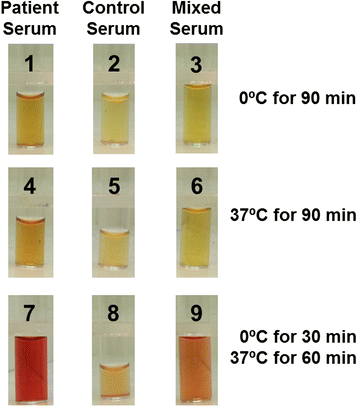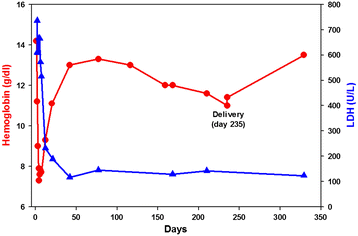Case report: paroxysmal cold hemoglobinuria presenting during pregnancy
- PMID: 25699184
- PMCID: PMC4334594
- DOI: 10.1186/s12878-015-0023-7
Case report: paroxysmal cold hemoglobinuria presenting during pregnancy
Abstract
Background: Paroxysmal cold hemoglobinuria is caused by a biphasic IgG autoantibody that triggers complement-mediated intravascular hemolysis. Paroxysmal cold hemoglobinuria has not previously been reported to occur in association with pregnancy.
Case presentation: We report a case of an 18 year old female who presented in early pregnancy with acute hemolytic anemia and a positive Donath-Landsteiner antibody test. She was diagnosed with paroxysmal cold hemoglobinuria and treated supportively. Her hemolysis resolved within 6 weeks. Because maternal IgG autoantibodies can cross the placenta, the patient was monitored closely throughout her pregnancy for recurrence. The outcome of the pregnancy was successful, with no evidence of neonatal anemia or hemolysis.
Conclusion: This patient had a classic presentation of paroxysmal cold hemoglobinuria with rapid onset of hemolytic anemia that resolved spontaneously. To our knowledge, this is the first report of paroxysmal cold hemoglobinuria presenting during pregnancy.
Keywords: Donath-Landsteiner antibody; Hemolytic anemia; Paroxysmal cold hemoglobinuria; Pregnancy.
Figures


References
-
- Sokol RJ, Booker DJ, Stamps R. Paroxysmal cold hemoglobinuria and the elusive Donath-Landsteiner antibody. Immunohematology. 1998;14(3):109–12. - PubMed
-
- Sanford KW, Roseff SD. Detection and significance of Donath-Landsteiner antibodies in a 5-year-old female presenting with hemolytic anemia. Lab Medicine. 2010;41(4):209–12. doi: 10.1309/LM1E9Z2QZEREPAI. - DOI
LinkOut - more resources
Full Text Sources
Other Literature Sources

